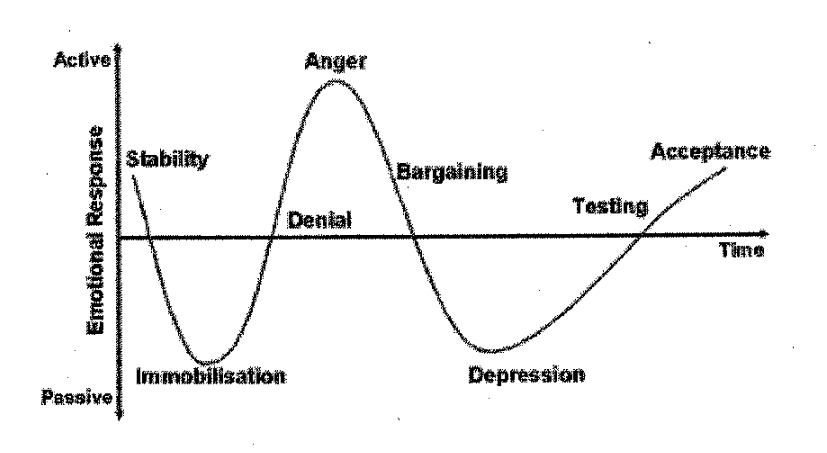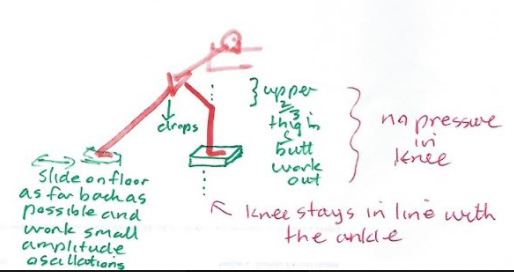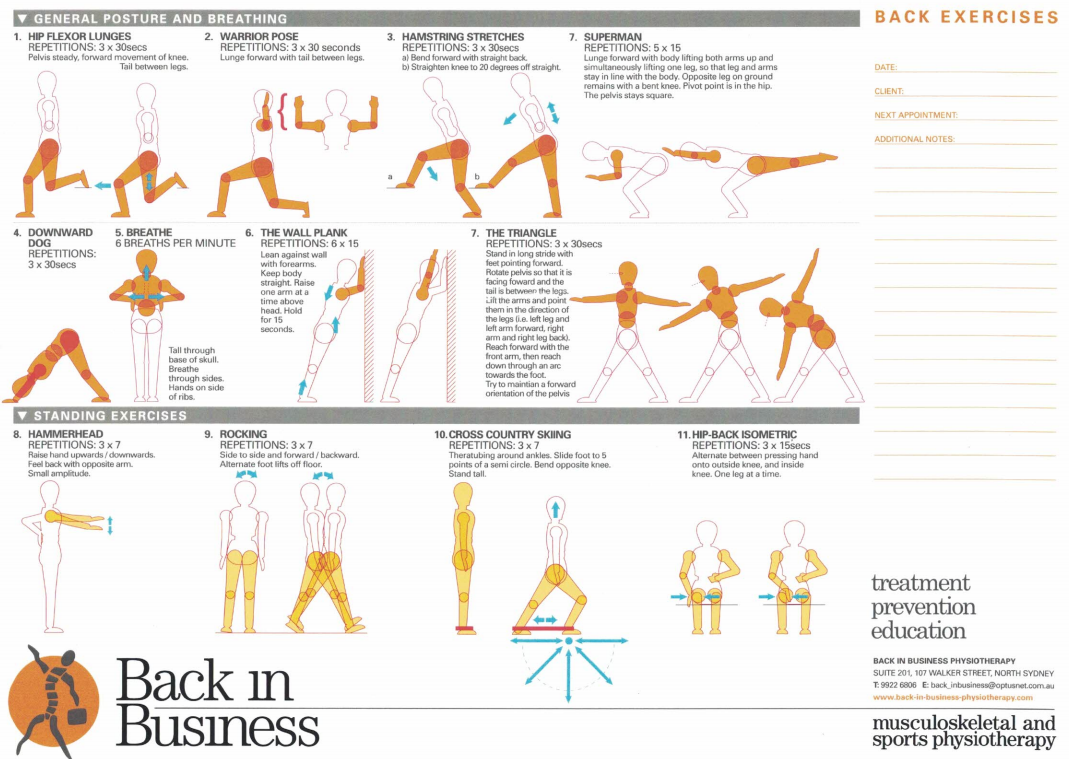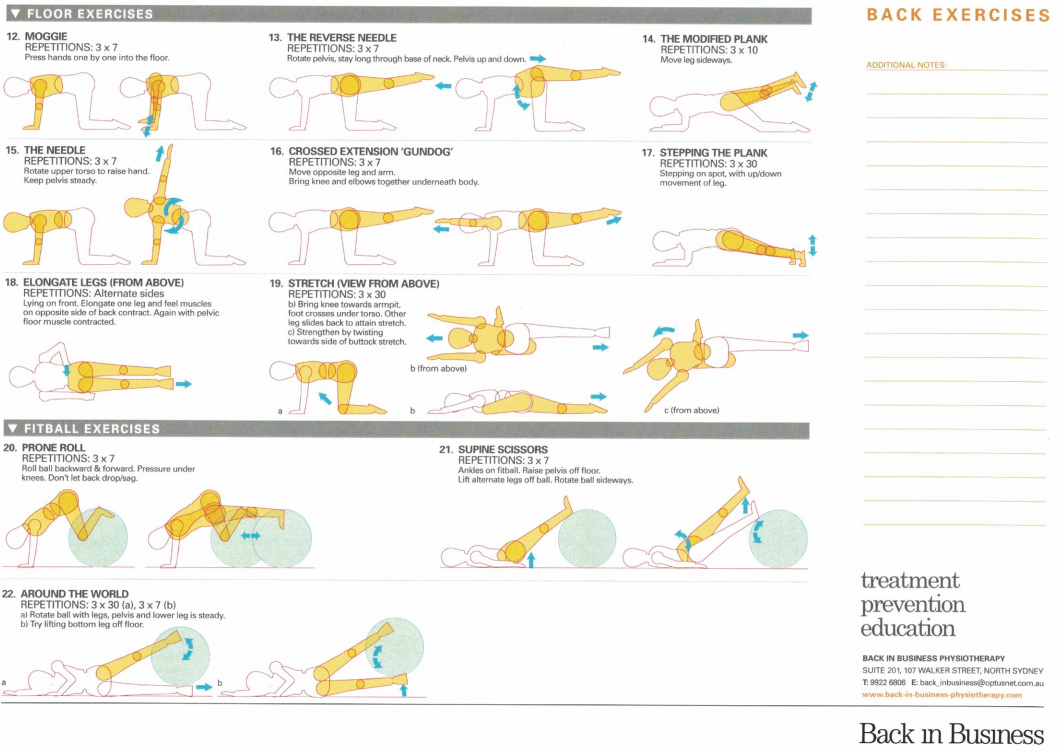Prevention of injuries in young competitive orienteers
Workshop presented in Andalo, Trentino, Italy on 2 July 2024
by Martin Krause (Musculoskeletal Physiotherapist)
hosted by Joergen Moertenson (legendary Swedish Orienteer and PWT owner)
Orienteering, especially at an elite level, requires a combination of physical, mental and cognitive agility. Essentially, its a task which requires the ability to move 'fleet of foot' through uneven terrain at optimal speed, whilst navigating sequential 'check points' using a detailed map (1:2500 -> 1:15000) and reading a compass.
The following discussion aims to enlighten young orienteers and their charges, to the first principles of competitive training and injury prevention. Evidence for my proposals are found throughout the over 500 pages of this website. Essentially, whilst an anecdotal presentation, it is based on the life-time 'wisdom' which I have gained, both professionally (working over 38 years in musculoskeletal and sports injury management including elite and professional athletes) as well as my personal sporting experiences across many disciplines, with orienteering, cycling and soccer being my favourite..
Physical attributes required for orienteering include
- foot/ankle, knee, hip and body stability
- balanced 'inverse dynamics' from the ankle to the torso and arms
- endurance - resistance to fatigue 'slow twitch' muscle fibre stability (Work = Power x Time)
- agility - co-ordinated power (Power = Force x Velocity)
- strength - ability to produce force (Force = Mass x Acceleration)
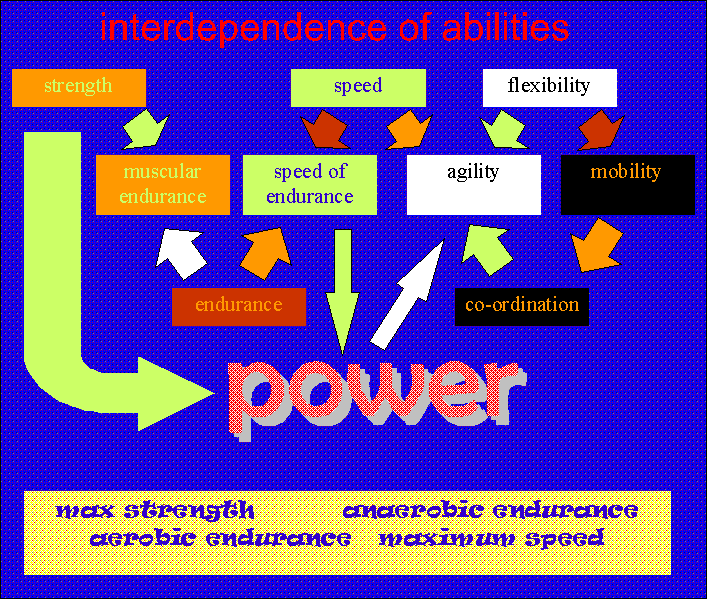
Good training techniques, need to be achieved for competitive results, This involves cognitive goal setting, using mental and physiological considerations, that result in the avoidance of injuries and the minimisation of lost training days through ill-health.
- Endurance : 'resistance to fatigue' and hence reduced risk of movement breakdown and injury : Work = Power x time
- Power : ability to produce movement under load without compromising stability : Power = Force x velocity
- Force = muscle mass and cross sectional area : mass x acceleration
- Acceleration = change in speed in varying terrain : velocity/time
- Velocity = displacement/time
Physical attributes should be differentiated from the physiological and neuro-immune attributes required for elite sporting performance.
Categories of injury
Adverse biomechanical conditions as a result of misuse, disuse, overuse, abuse results in damage which can cause a vicious reciprocating cycle of muscle-tendon atrophy, degenerative changes, and immune-metabolic dysfunction.
- Misuse - poor technique e.g. asymmetrical push off, from previous ankle sprains, resulting in Achilles Tendonopathy
- Disuse - prolonged periods of rest as a result of illness or injury
- Abuse - trauma such as ankle and knee sprains, muscle strains
- Overuse - poor periodisation of training volume resulting in over-loading. Usually as a result of over-reaching. Fail to plan, then plan to fail. Use a training diary for transparency and accountability, which should avoid over-training syndromes including mood disturbances (3 bastards in a day)
Causes of injuries
Injuries in orienteering can occur within and without competition. Generally, athletes feel that injuries occur due to 'bad luck'. If we consider the inverse 'good luck', then consider it's definition 'when good preparation meets opportunity'.
Injuries occur as a result of
- fatigue (mechanical and metabolic)
- lack of co-ordination and strength
- inexperience - lack of technical and physical experience in various terrain and cognitive loading conditions
Fatigue can be
- metabolic - insufficiently trained oxidative capacity
- cardiac - output as a result of heart rate and stroke volume
- mechanical
- insufficient hypertrophy of 'passive' soft tissue and bony structures
- insufficient muscle adaptation of contractile and synergistic systems
- immune - under appreciating the importance of considering muscle as one of the most important organs of the immune system
- gut - energy species and biome interacting with muscle in a symbiotic relationship
Cognitive
- adaptation to physical and mental stress through training (not over-training)
- map reading and other psychological conditions to perform functionally in both sport specific and non-sporting environments
Injuries can be avoided by adaptive loading the body through sports specific
- Periodisation of training
- Nutrition - both energy, immune and anti-oxidant considerations
- Specific exercise tasks
- Progressive resistance gym training
- Plyometric exercises
Races are won and lost by the ability to run quickly downhills and traverse steep terrain. Learning to master these biomechanical attributes, not only optimises performance, it reduces the risk and probability of injury.
Considerations in the young female athlete
Young female athletes may be dealing with their menstrual cycle for the very first time. Things to consider are
- the menstrual cycle itself - is it regular
- the onset of menstruation (menarche)
Delayed onset of the menstrual cycle or irregular menstruation can be the result of over-training. Consequences can be multifactorial. In terms of the musculoskeletal system, reduced bone density can occur, which may lead to stress factures. In countries with poor access to sunlight, these factors can be exacerbated by the lack of Vitamin D. Additionally, if the winter ground is frozen the heightened risk of stress fractures is compounded.
If the menstrual cycle is regular, please consider
- excessive blood loss - need to check ferritin and hence iron levels
- the luteal phase, where muscle reaction times may be reduced and when ligaments might not be as stiff as usual
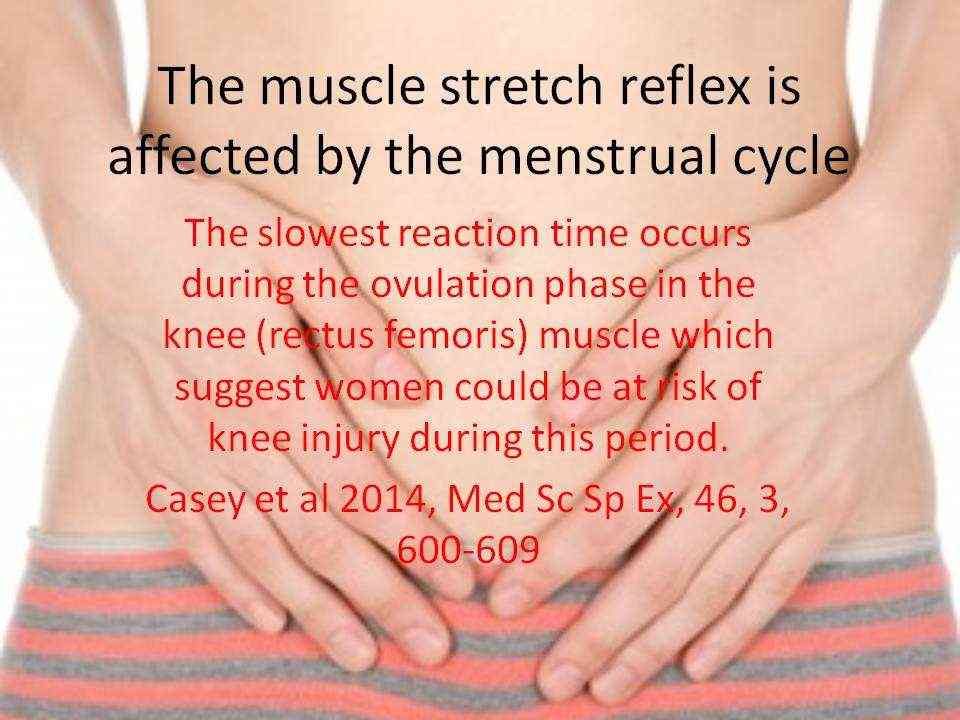
Investigators have found that aerobic athletic performance is compromised during the mid-luteal phase compared with the mid-follicular phase of the menstrual cycle (Freemas JA et al 2021 Med Sc Sp Ex, 53, 2, 442-452).
Researchers looking at US insurance claims between 2007 and 2017 found that women on the pill were less likely to have an ACL injury whilst playing sport. Reconstructive knee surgery was performed on 569 out of 82874 women who were not on the pill versus 465 out of 82874. Thus the synthetic oestrogen and progesterone hormone were considered protective against knee injuries (De Froda et al 2019,The Physician and Sports Medicine, April).
Interestingly, high specialisation in female youth soccer players is associated with the increased likelihood of sustaining a serious injury (Xiao et al 2021, Med Sc Sp Ex, 53, 10, 2086-2092).Current youth soccer players are specialising earlier and committing to play college soccer at a younger age compared with when current college and professional soccer players did. Suggestions are that a youth soccer player shouldn't spend more hours training per week than their age. Additionally, issues of 'burn out' may also occur.
Growth Spurts - earlier in life in girls than in boys
This can be a very important factor when applied to power and flexibility. The bones can grow 18 months in advance of your muscles. This could mean feeling very stiff. Additionally, certain biomechanical features can become unstable, such as the patella (knee cap) tracking, within the quadriceps, as well as excessive hamstring tightness.
Girls can be more affected than boys, as their growth spurt and adolescence frequently occur 2-4 years before boys. Importantly, the overall maturity of the body, muscle mass and life experiences, are less developed in the female, if their adolescence comes so much earlier. Menarche and growth spurts appear to occur so much earlier than in past generations and it's not uncommon for a 10 or 11 year old girl to experience her first menstruation.
Morphometrics
Morphometrics describes a person's body type. It's not uncommon for 'chubby' mid teens boys to turn into 'bean poles' in their late teens. Training and movement patterns will vary, purely due to the centre of gravity and length of the body levers. With longer levers, the bigger the inertia, and the more there is to control.
Endurance training
Orienteering is an endurance sport. Coaches as well as individuals will place a lot of emphasis on the physiological requirements (Heart Rate Max = 220 - age) which makes an endurance athlete. These zones are taken from road and track cycling programs in the 1990's.
Zone One (<70% HR max): very low level light exercise, too low in itself to induce physiological adaptations. Minimal sensation of effort or fatigue. Easy to hold a conversation. Used as a recovery strategy between bouts of exercise (intervals) or as a recovery strategy after a hard training session or long race.
Zone Two: (endurance 71-80% HR max): classic long slow all day long distance training. Good for gaining and endurance base. However, if too much time is spent training slow, you become slow. Recovery from 2 hour sessions should be quite rapid, whereas longer sessions with some moderately fatiguing climbs may take 1-2 days to recover
Zone Three (tempo 81-85% HR max): intensity as a result of speed. Frequent sensation of fatigue, concentration required, conversation becoming difficult. Daily sessions possible so long as adequate energy requirements are met. HR recovery may be a good test to indicate how well you have recovered.
Zone Four (lactic threshold 86-94% HR max): efforts similar to time trials on a bike. Continuous conversation very difficult. Continuous sensation of effort or fatigue in muscles being exercised. Mentally very taxing and generally performed in blocks or repeats of exercise with some recovery between bouts but not too long e.g. running 1-3 minute blocks with 1-3 minute rest in between; cycling 10-30 minutes with 10-30 minute recovery between blocks of exercise. Consecutive days of training possible, but check HR recovery every morning and also maintain an immune enhancing diet. Not wise to do just before a big race. Also unwise to do if there is a lot of other stress in your life. Recovery is super important.
Zone Five (95-120% HR max): short intense bouts of activity. Running 10-30 seconds, Cycling 3-8 minutes. Strong to severe sensation of fatigue. Laboured breathing. Repeated consecutive days of training not recommended and considered undesirable
You want to get to a point in your training and elite sporting career where lactic acid is not a performance limitation but a useful energy substrate
Elite Swiss orienteers run 5000m track at under 15 minutes. Matthius Kybutz qualified for the Paris 2024 Olympics running a marathon in sub 2hrs07mins. You need to be fast to be an elite orienteer and elite performance takes time. Goal setting can be a weekly, monthly, yearly or even something which evolves over a decade. Most successful elite sports people knew what they wanted to achieve as teenagers. It takes 10000 hours of quality practice to reach expertise.
Take home message : high metabolic intensity of training needs to be met by good preparation.
Warning : if training in heart rate zones, make sure your day isn't stressful in itself, creating a high resting heart rate, because you have too many things to do!!
A by-product of physiological loading is mechanical loading of muscles that activate an inflammatory - immune response
Metabolic fatigue can lead to immune compromise : These extreme physiological training principles of zone 3 -> 5, carry the risk of severe metabolic over loading unless prior muscle conditioning has been achieved. Well prescribed exercises can 'fine tune' muscle immune responses. Conversely, over-training, from poor preparation, can lead to immune and mechanical compromise within muscles, leading to under-performance, lost training opportunities and potential injury.
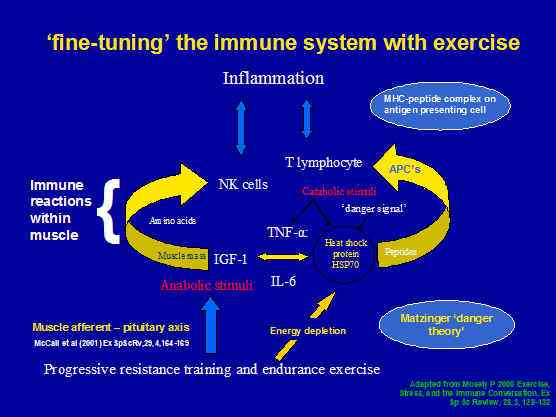
Heat shock proteins (HSP's) as well as several immune substances and neuropeptides (TNF - Tumour necrosing factor, IL - Interleukins, IGF - Insulin Gene Related Factor, NK - natural Killer Cells, T - lymphocytes, etc) reside within muscle and it's myo-fascia. These substances are released during physically demanding activities, due to mechanical and/or metabolic strain/stress to induce, either a positive (anabolic) or negative (catabolic) training impact, Therefore, the response can be 'fine tuned' depending upon the appropriateness of loading and recovery, based on the preparation, stage and stability of the athletes mechanical and metabolic conditioning.
It is important to understand that the immune system is stimulated during exercise, but undergoes a compensatory 'blunting of immune response' in the 2-4 hours post exercise. During this period it might be wise to avoid crowded spaces, as well as try to consume a carbohydrate-protein drink, such as a 'banana smoothie', immediately following exercise.

Cortisol - a natural anti-inflammatory stress hormone reduces, as do lymphocytes and natural killer (NK) cells
Take home message : consider how to optimise the immune response. Immune highs and lows in reaction to the metabolic and mechanical demands placed on muscles, must consider recuperation between bouts of exercise.
Warning - after intense exercise, try to ingest carbohydrates and protein within 2 hours of cessation of exercise. Also, avoid crowds 2-4 hours after intense exercise, as your immune responses go from a high during exercise to a post exercise low, before returning to normal. Additionally, the structure of training camps may need to take into consideration minimising the exposure to crowds in confined spaces, as well as the 'periodisation' of training (explained below). It may be prudent to do the volume and intensity training initially, whilst using the latter stages for technical training, planning, cognitive and psychological exercises, if aeroplane or train travel is going to occur, for the trip home. My anecdotal experience was that a 10 days training camp was OK, whereas a 2 week training camp resulted in a lot of athletes getting sick, generally with Upper Respiratory Infections.
Delayed Onset Muscle Soreness (DOMS) - overuse
Mechanical fatigue can lead to immune compromise : Muscles contract using a sliding filament mechanism, whereby two filaments - actin and myosin use a 'ratchet' 'cog and rack' like mechanism to shorten and lengthen muscles. These filaments are held together by various cross bridges. DOMS can occur, when unaccustomed exercise is introduced to the training program. Frequently, these are activities which involve muscle contractions whilst the muscle is lengthening (eccentric contractions). Running downhill would be a good example of quadriceps controlled lengthening through muscle contraction. (later it will be explained why running downhill using the hamstrings and gluteal muscles as a synergy to the quadriceps is so important). One simple theory behind DOMS is the 'broadening and streaming' of the Z discs. This can lead to swelling within muscles as a result of the release of inflammatory neuroimmune peptides. Microscopic changes to the cross filaments can last 28 days. Whilst it may seem simple to say, avoid such contractions, training to change the mechanical efficiency of muscles does require some 'damage' and remodelling into a more loading tolerant system. To reduce the risk of mal-adaptive changes, specific functional exercises that involve components of, as well as, entire muscle synergies are required. These exercises should introduce optimisation of the mechanical loading of the entire limb, ideally for downhill and uneven terrain running.
Take home message : high metabolic demands of training is accompanied by high mechanical demands depending on which type of training is used (e.g. contrast the (low) mechanical demands of bike riding training in a transition or preparatory phase to the (high) mechanical demands of downhill running training during a competition phase
Oscillatory systems - the rate of relaxation
Importantly, muscle contractile efficiency, in endurance sports, is determined by how well muscle relax and how few motor units are recruited to perform the optimal function. This is partially why muscles become stiffer as we fatigue, which sets up a cycle of less relaxation and more fatigue, being rate limiting and a protective aspect, by the body, to prevent catastrophic failure (Rhabdomyolysis). The better prepared the athlete, the more fine tuned and appropriate, the response.
In endurance sports, a muscle never contracts 100% of it's motor units - there is always redundancy in the system. Furthermore, there is frequently an asynchronous pattern of motor unit firing. Moreover, when examining this asynchronicity, in terms of 'deterministic chaos', repetition under variable conditions, means the 'outlier' becomes the reference point of what is considered 'normal'. This means that training should include, not only 10000 hours of repetition, but varied qualitative repetition, to not only avoid injury, but to optimise the system to become competitive. Hence, specific exercises below, include oscillatory ones, designed to maximise the contraction - relaxation cycle. These include exercises such as the 'Hammer Head', 'Queen Mum' (rocking), 'Moggie', 'Reverse Needle', 'Hip Hitches', 'Quads Hover' , 'Reverse Lunges' (skating) leading to the plyometrics box, hopping, skipping, and downhill running.
Magnesium supplementation
Magnesium supplementation (200mg for women, 200mg for men) can aid in muscle relaxation. Magnesium is the counterpart to calcium. Calcium makes muscles contract, leakage of calcium from damaged muscle tissue, means that muscles continue to contract. Magnesium is usually 'the gate keeper' of calcium, helping muscles relax. Additionally, magnesium supplementation also seems to improve glucose balance in the blood stream during exercise. The mechanism may be through better uptake of glucose , by muscles, through Glut-4 pathways.
Differentiation of the metabolic and mechanical demands of training for a positive training effect, thereby avoiding or reducing the risk of injury

Presentation in Rome 2005 for further reading
When considering such a model, ideally the joint loading is minimised through the use of bi-articular muscles. In the case of downhill running, the hamstrings and calf bi-articular muscle 'energy straps' circumventing loading on the knee joint. Additionally, this action simultaneously reduces the loading of the quadriceps near the knee, whilst increasing it's loading in the upper 2/3 towards the hip. Thus a series of stabilising contractions in the lower limb. leading to further mechanical energy dissipation in the gluteal and core muscles of the pelvis. Those athletes who ride a bicycle will know how riding uphill in a seated position tends to load the posterior 'slings', whereas getting out of the saddle has a tendency to increase the loading of the anterior 'slings'. Ideally. a 'sweet spot' is reached between the 'slings'. This stabilisation and optimisation, is particularly important, as the loading around the knee can reach up to 3 - 7 times body weight, when (leaning back whilst) running downhill. Exercises (to balance the slings), involving actions which mimic 'downhill skiing', 'reverse lunges' and 'nose behind toes' plyometrics box activities will be described later in the exercise section.
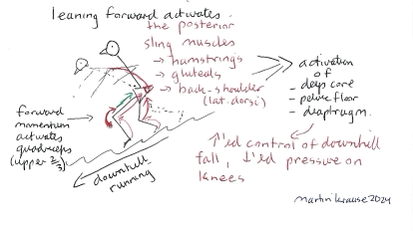
Leaning forward (in the hip joint) during downhill running, not only lowers the centre of gravity, it allows the conservation of momentum, as well as the engagement of the stabilising elements of the sling configuration, whereby the activation of the posterior 'sling' activates the hip-pelvic-thoracic stabilising mechanisms, as well as proximal quadriceps activation. The amount of forward flexion around the hip joint will vary depending upon the persons anthropometric features (taller vs shorter, skinny vs robust).
Warning : you will get DOMS when initially undertaking this form of exercise. Primarily focus on learning the task on soft ground or comfortable cushioned shoes. Do, the reverse lunges and quads hover exercises described below, as well as plyometrics training as pre-conditioning for forward leaning downhill running. Over time, the DOMS experience will reduce and the type of terrain won't make a difference. Remember, the forward lean occurs in the hip, the back remains straight, and the abdominal muscles along with the posterior slings absorb most of the energy, whilst the quadriceps are performing in a shortened range. Ideally, the foot is flat throughout the landing phase of running. This latter aspect is also useful in preventing ankle twisting injuries in soft and uneven terrain. Landing on the ball of the foot adds to the degrees of difficulty (complexity of stability) and should only be used in terrain which hasn't any 'give' such as rocky ground.
Importantly, there are two types of 'slings'
- ones that have a 'bow and arrow' effect whereby the greater joint angle creates the greater tension and hence recoil velocity
- ones that are stabilising, acting like a 'hammock', cradling body parts into a synchronous harmonic spring like motion
Take home message : by differentiating and reducing aspects of training and movement into first principles, will allow the athlete and coach and physiotherapist, to set an appropriate training plan, which is objective, transparent and thereby accountable. Hereby, optimising performance, through a thorough understanding of technique, leading to a reduced risk of injury, with increasing training load. Exercises are used to build individual aspects into a functional comprehensive competitive unit.
Mechanical - metabolic - immune conversion
Importantly. muscles are an organ of the immune system as well as an organ of locomotion. Beside, optimisation of mechanical loading capacity, protective principles to avoid immune compromise, inflammation and injury include
- contrast bathing
- periodisation of training
- progressive resistance weight training
- power and agility training using kinetic chain 'sling' synergies and plyometric type exercises
- environment - don't go into crowded spaces in the immediate 2 hours post training.
- nutrition - carbohydrate and protein loading before, during and immediately after physical activity. These factors are particularly important during periods of intense training and/or competition. Periodization of training can aid in avoiding 'breakdown' as a result of insufficient recuperation and adaptation to training regimes.
Heat and Cold Shock Proteins
Saunas and cold immersion baths have been advocated for recovery from training and competition. Both are considered to improve the immune system through the release of either heat or cold shock proteins (HSP, CSP). These basic short peptide chain substances are considered to be the basic building blocks of evolution and the development of multi-cellular life on this planet. Inside our muscles, these can be considered basic building blocks of healing and repair. They form complex synergistic relationships with other longer chain HSP (eh HSP 27 and HSP 72), within muscles (mechanical stress, e.g. delayed onset muscle soreness DOMS) and potentially through oxidative stress (metabolic fatigue) form another synergy with (HSP) immune and energy species in the gut? Furthermore, cold immersion therapy can also be used to potentiate microcirculation, reducing clinical and sub-clinical swelling. Although, the precise relationship is complex and still not fully understood, the fact that this form of therapy has been used for thousands of years, in many parts of the world, at least on the face of it, makes the use of sauna and cold immersion baths, a valid strategy to use
Periodisation of training in the prevention of overuse injuries
Periodisation of training and correct technique reduce the risk of over-training, 'staleness', immune compromise and injury by considering the importance of rest, nutrition and correct biomechanical and physiological loading.

Volume - duration : protective endurance base from which Intensity is developed.
(eg long slow run, multi-sport, vs fast runs such as interval training, Fartlek, sprints, power training in gym)
Rule of thumb: don't increase volume and intensity at the same time. If over-training and staleness sets in, do the opposite of what they have been doing. When we were working with elite amateur and professional cyclists, if a track cyclist was going stale, we'd put them on the road, and the opposite, when a road cyclist was going stale we would put them on the track (velodrome) or we send them on holidays, where 'less is more'.
- Preparatory ; Training phases may be separated into various stages depending upon the age of the athlete and whether the athlete is a novice or experienced. General physical abilities may include multilateral/dimensional development of endurance e.g. using bike riding and swimming or even a team sport like soccer, to develop agility, as an adjunct to running training, to prepare for the volume of training required during sport specific orienteering training and competition. Specific physical training may mean more time devoted to the particular run e.g. 5000m vs 10000m vs hurdles vs orienteering and less time devoted to other sports. Importantly, these forms of training need to be monitored as their intensity could lead to injury before the competitive season has begun.
- Competitive : As training proceeds into the competitive phase some athletes place a higher proportion of their loading on intensity whilst reducing the total volume of training. Cycles such as this one may be biannual or biennial. Importantly, periodisation and cyclic loading is not restricted to any particular time frame. Although, it does place emphasis on incremental loading moreover it places emphasis on optimal regeneration and recovery. Additionally, such a methodology provides a 'base' for the next cycle of training activities. Each macrocycle may be made up from micro cycles which can last days, weeks, months or years. Remember, each time you train to change your bodies abilities you are stressing the system and therefore recuperation and repair is important.
- Transition : seasonal - 'time out', regeneration/recovery, multi sport during 'off season' or a micro cycle of the low volume/intensity day/week/month, working back into the preparatory phase
Training phases

Protective exercises can be prescribed for the different training phases. Generally, a good endurance base is considered important to prevent injury from much higher mechanical loads which can occur during power and speed work outs, or during periods of intense competition.
Endurance training (volume loading) - periodisation
How to develop endurance and volume of training without over-training.
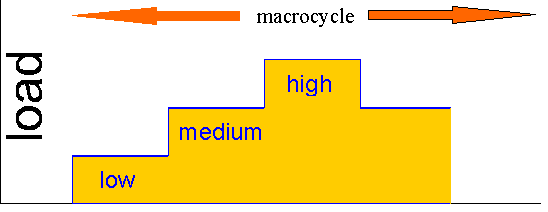
Periodisation of training allows the athlete to gradually build up their training volume or intensity, whilst allowing time for regeneration. Gradual increments of loading can occur, whilst reducing the risk of excessive over-loading and hence injury. Additionally, training of various intensities allows the metabolic systems to develop in parallel. Thereby the anaerobic and aerobic metabolic systems can be used to drive endurance, reduce fatigue and the risks of injury associated with movement breakdown from fatigue. Lifestyle factors need to also be considered. How much time do you really have for training, work/study, friends/family and recreation? Ideally, when study volume is increased, quality (intensity) of training is high and volume (duration and frequency) of training is low. However, intense training can only occur safely, only a pre-existing endurance base.

On a micro level an orienteering competition is similar to periodisation, with intense anaerobic intervals, such as running uphill, requiring a medium or low interval for heart rate recovery, which can occur when running downhill or on flatter terrain. Even after coming out of the forest and spending a short period running on a track or road, may potentially be considered a transition phase?
Take home message : the endurance base is like the foundations of a building, where the athlete can soar to new heights, by adding intensity on a robust musculoskeletal structure
Periodisation of training and injury - disuse
Paradoxically, the more refined your training and competitive regimes, the greater the 'perceived error', Training regimes, to a large extent, can be quite predictable. However, high level sport has many levels of 'randomness', where being on a 'knifes edge' can mean the difference between success and failure. The key element is to have the defined variables distinguished from those seemingly 'random' aspects of competitive sport. By having a solid routine, resilience to changes in expectations/outcome can becoming a solid learning tool, if the appropriate analysis is undertaken. Those 'random outliers' may be an insight into a better training methodology or competitive technique.
Periodisation of training, ideally allows the athlete to avoid injury. Moreover, if an injury or illness does occur, understanding and using the concepts of a 'low' intensity training phase gets the athlete used to building up from an injury induced 'low' training phase. Additionally, the transition and preparatory phases give the athlete familiar alternative sports and exercises to do, during the recovery from injury. Moreover, if sport is the athletes main socialiser, then friends in other sports may become extremely important for mental wellness as well as physical strength.
The Kubler Ross model of grief are applicable when it comes to chronic sports injuries.
Mental health among athletes is an important consideration that has recently gained more attention. The 2019 International Olympic Committee (IOC) consensus statement on mental health in athletes reported on the high prevalence rate of mental health symptoms in athletes and the relationship of mental health with physical injury and subsequent recovery (Reardon CL et al 2019 Br J Sports Med. 53, 11, 667–699). The IOC urged that mental health is a vital component of athlete well-being and cannot be separated from physical health. Assessment of mental health and subsequent management should be a routine part of the medical care of athletes. The IOC also concluded that cognitive, emotional, and behavioural responses are important factors in injury outcomes, and mental health disorders can complicate recovery. A systematic review of 28 studies reported 65% of those patients not returning to play cited a psychological reason for not returning (Nwachukwu, BU et al 2019 Orthop J Sports Med. 7, 5, 23259 67119845313). Fear of reinjury, lack of confidence in the knee, and depression were the most commonly cited psychological reasons.
Take home message : Periodisation of training should provide the athlete with good time management principles, including time for work/study, family, friends and recreation. These aspects become even more important, as they can act as a 'safety net' during periods of injury and recovery for physical and mental health reasons.
Fast and Slow twitch muscle fibres - the 'floppies' and the 'stiffies'
Anatomically, endurance muscles are deep muscles, close to the joint, generally only cross one joint and are slow twitch red muscle fibres. Muscles for power are 'fast twitch' white fibres which are more superficial and cross more than one joint and even multiple body segments.
People tend to be divided into two categories - the 'floppies' and the 'stiffies'. Floppies tend to be inherently ballistic in their movements - sprinters. Conversely, stiffies tend to be endurance athletes. Frequently, stiffies need to do speed, flexibility and agility training, whereas floppies need to do endurance training, to protect themselves from injury.
Importantly, to do these aspects safely, a gym or home exercise program can be employed, where variables can be controlled and good technique is monitored. Hence, prevention of misuse from lack of movement or lack of control of movement should use
- specific endurance exercises with the principle of 3 sets of repetitions to metabolic fatigue, with a short recovery period between sets, with low loads
- specific strength exercises involving few repetitions using high loads to mechanically fatigue muscle cross fibres and tendon. Long recovery time between sets
- plyometrics speed rebounding exercises, for power, which provide a mechanical and immune protective mechanism against the stresses of training and competitions
Take home message : floppies naturally have power but reduced endurance from lack of stability, whereas stiffies have enhanced stability but reduced mobility. Plyometrics training for the former involves control of movement during metabolic fatigue, whereas the latter, involves improving range of movement whilst encouraging biomechanical fatigue. The ultimate objective is power through velocity of muscle rebound.
See : Ehlers Danlos or Joint Hypermobility Syndrom link for further information
Musculoskeletal stress, cognitive demands and the immune system - misuse
An injury can commence in one part of the body and gradually affect other parts of the body, as a redundant compensatory systems become the primary player, protecting the other body part (original injury),
Recovery may involve analysis of technique, examination of training load (duration, frequency, intensity), adequate rest and nutrition, as well as a sound state of mind (mental strength). Redundant compensatory use can eventually lead to fatigue and overuse of those body parts. A classic example is when the hip begins to lose control of rotation, the knee compensates by acting not only primarily as a 'hinge joint' but increases it's function as a rotator as well, which can lead to knee and ankle sprains, Inefficiency of movement can also lead to increased energy requirements leading to premature fatigue, muscle strains, stress and immune compromise.
Overtraining - over reaching = immune compromise
More isn't necessarily better. How much time do you really have for training, recuperation, work, study, family and friends?
Over-training has been shown, within 4 weeks, after the onset of training, to be associated with increased oxidative stress both at rest and during submaximal exercise in a group of men after they underwent 7 weeks of intense military training (Tanskanen et al 2011, Med Sc Sp Ex, 43, 8, 1552-1560)

A common symptom of over-training is non-restorative sleep, immune compromise and stress fractures. Approximately, 1/3 of young athletes have experienced 'non functional over-reaching (NFOR) or over-training (OT) at least once in their sporting life (Matos et al 2011, Med Sc & Sp Ex, 43, 7, 1287-1294). The rate was higher in individual sports (37%) when compared with team sports (17%). Individual sporting endeavours tended to consume more than 2 hours per day, 6-7 days per week, which was significantly greater than the training volume reported in team sports. Females were more prevalent in the OT cohort (36% vs 26%). Moreover, even in low physical intensity sports such as golf individuals may suffer from NFOR/OT. Training load and volume alone wasn't the sole contributor to OT, as sporting individuals appeared to devote more time to their sport and less time to socialising and other school activities. Thus, they are at risk of developing a uni-dimensional personality which seems to place them at risk for NFOR/OT. Self esteem, identity and self-worth become intertwined which is fine whilst they are gaining sporting success, however sporting failure may result in stress and anxiety. Hence, young athletes should be encouraged to form multi-dimensional personalities through encouragement of a range of hobbies and interests.
Over training in female athletes can be particularly severe as O-T leads to alterations in the luteal phase of the menstrual cycle which results in dysmenorrhea and potential reductions in bone mineral density and metabolic dysfunction due to reduced Oestrogen levels.
Heart rate variability
More precise monitoring of the rate of recovery can be achieved by examining 'Heart Rate Variability' whereby the response of the heart from 3 minutes prone to 2 minutes of upright posture is measured. High variability dictates a fresh response - low variability indicates a 'stale response' or high stress related fatigue. This allows the athlete to more objectively determine which days should be recovery days and which ones are days where they can train a little harder. Importantly, chronically reduced HRV is suggested to be a 'red flag' for sudden cardiac arrest in otherwise fit and healthy individuals. Such individuals should have further testing by a cardiologist before recommencing their training regime.
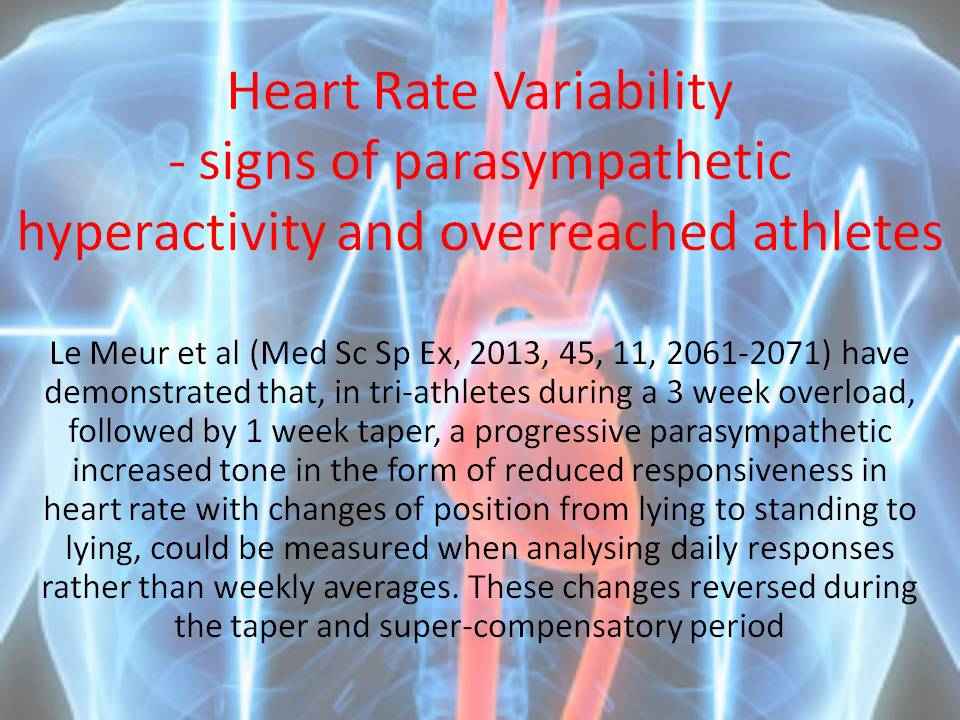
Metrics should be used in the evaluation of fatigue, just as they are used in the evaluation of performance.
In hypermobile 'floppy' people excessive HR variability can be the problem rather than dampened response. POTS is a condition of exercise intolerance in positions other than the horizontal. Athletes will often present, complaining of symptoms of dizziness in standing, whilst feeling comfortable in sitting and lying down. In the older person it can be a result of cardiovascular deconditioning where the Heart Rate and Stroke Volume do not produce enough cardiac output (CO=SVxHR). In the younger individual, it may present as part of a condition from a different aetiology. In people who have suffered a Whiplash Associated Disorder (WAD) - anterior sympathetic cervical ganglia, or in a person with concussion, POTS symptoms may arise. Additionally in people who have Ehler Danlos Syndrom (EDS) or Joint Hypermobility Syndrome (JHS) POTS like symptoms due to autonomic dysregulation may present with POTS at any stage of life. Any thoracic ring issues which affect the peripheral sympathetic ganglia may also result in POTS like symptoms. Essentially, a person may have low blood pressure and elevated heart rate (Tachycardia) as a compensatory mechanism. POTS is frequently misdiagnosed and requires a tilt table and blood pressure monitoring to aid in the differential diagnosis.
further reading : https://www.back-in-business-physiotherapy.com/latest-news/335-postural-orthostatic-tachycardia-syndrome-pots.html
Sleep and irritability - the 3 B's
Sleep is particularly important for adaptation to training. There are essentially two immune systems
- adaptive - the one we develop in response to environmental stressors
- innate - the one we are born with and has a very strong genetic pre-determination
One immune system is more active during the day and the other more active at night. At night immune and inflammatory reactions to the physical and mental loading of the day are activated for tissue building, healing and repair.
Hormonal balance at night should be anabolic (testosterone, progesterone, oestrogen) muscle building vs catabolic (cortisol), muscle depleting.
A sign of overtraining is non-restorative sleep, waking in the morning and feeling tired. This can lead to the 'three bastards in a day phenomenon'. When we meet one person in the day, whom we don't particularly like, we might think that's unfortunate, when we meet a second maybe doubly unfortunate, if we meet a third, then it's not them but you. Overtraining can lead to immune compromise and ill health. Ask your partner, spouse, close friends if you're in over-training.
Take home message : when setting out your training plan, ask yourself how much time do you realistically have to
- train
- sleep
- spend time with friends, partners, and family
- work/study
- RECUPERATE
Periodisation of training should incorporate these aspects of life into your training plan.
Don't train when you are sick
As already mentioned, muscles have a dual role of
- locomotion
- immune conversations

When you are sick, muscle protein and immune substances are required for recuperation. Training isn't only unwise, it's probably a complete waste of time.
- importantly muscles interact with the gut and it's energy deriving species, as well as with immune substances inside the gut, including heat shock proteins.

It should also be noted that for most common viruses which we associate with 'colds', it can take up to 6 weeks before the immune muscular system is fully recovered.
Nutrition
Nutrition should consider
- energy substrates (carbohydrate, fat and protein)
- anti-oxidative (Vit C, Blue Berries, etc)
- pro-biotic (Sauer Kraut, Kim Chi, etc)
- nitrogen balance
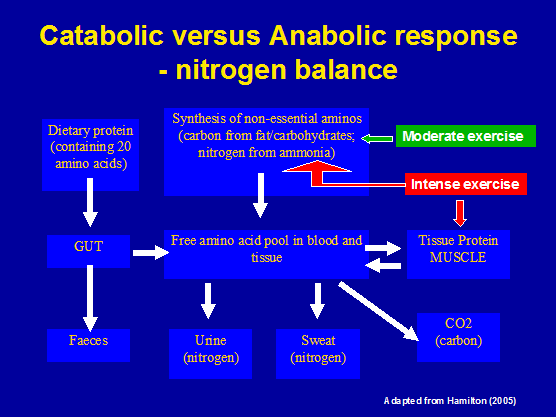
Warning : long duration physical activity such as marathons and ultramarathons are known to cause increased protein (especially albumin) excretion in the urine. Additionally, purine, a protein associated with ATP production, which is important for muscle contractions, is known to affect athletic performance. However, too much purine is also associated with gout like symptoms, resulting in joint inflammation, from high uric acid concentration, which can lead to crystals forming within joints. It is probably wise to monitor and even reduce excessive meat, alcohol, spicey food and seafood consumption during periods of intense and prolonged physical activity. Tables of purine rich foods can be found on the internet. Overall, however, good physical conditioning, generally results in enhanced purine modulation.
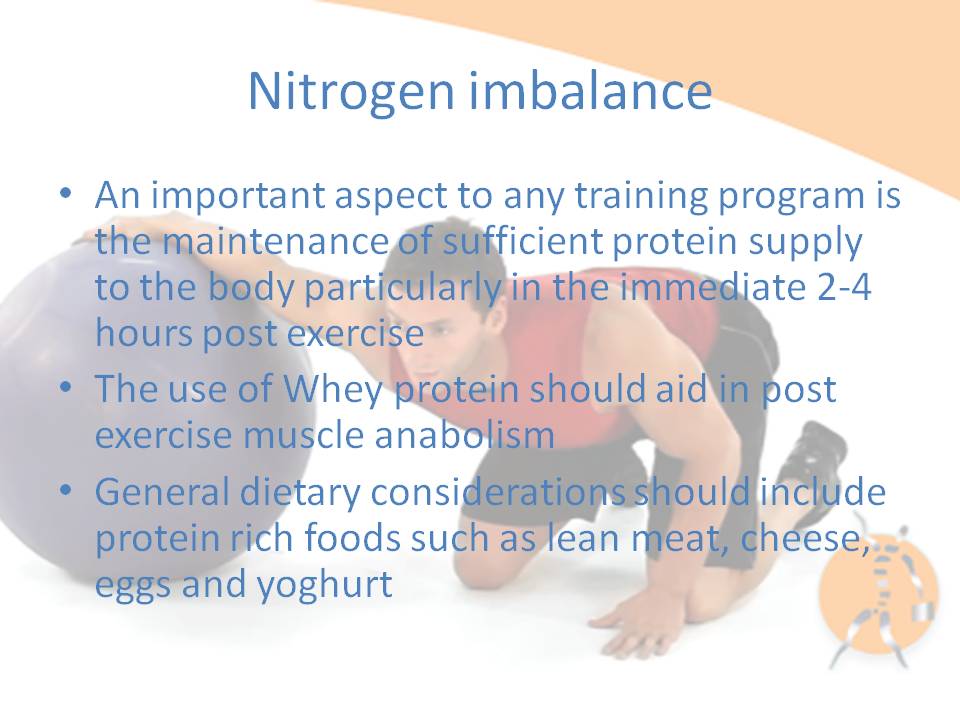
Flexibility
Hatha flow yoga is a good form of stretching without compromising stability. Can be done by both 'floppies' and 'stiffies'. A lot of emphasis is placed on the mobility and strength of the thorax through breathing, rotation and side bending movements whilst the limbs are either loaded or unloaded. A general rule of thumb, is that flexible people should draw stabilising forces inwards into the body, whilst stiff people should be mobilising outwards. It should be noted that people can have stiff muscles and loose joints. In many cases this is because the body is trying to protect a weakness. Therefore, with every mobilising exercise, the stabilizing component should also be considered. If nothing else, yoga will teach you to breath properly as well as relax and become more in tune with your body. This should mean that the 'self-awareness' gained by flowing through yoga positions will act like an internal monitoring system, alerting the person about potential problems before they arise rather than the first awareness being that of pain.
Strength : fast twitch mobilizing muscles
Strength training usually involves a gym program where the ability to move loads (mass) progressively improves. Benefits can be attained within 6 weeks. Fast twitch muscle fibres tend to cross more than one joint and act as 'energy straps' across different parts of the body e.g. hamstrings cross from the shin to the pelvis thereby transferring energy to the pelvis without compromising/over-loading the knee or hip. These energy straps or slings are very important in the prevention of injuries but also in the approach to rehabilitation.
Endurance : slow twitch stabilising muscles
Endurance training involves developing 'resistance to fatigue' over a 12-16 week period. Slow twitch muscles usually lie very deep and close to the joint. They tend to cross only one joint and provide localized stability over very long periods of time. Progression of training as well as recovery from injury shouldn't ignore endurance at the expense of 'ballistic power'.
Misuse : repetitive incorrect microtrauma through non optimal loading
In orienteering and running in general this results in tendonopathy, commonly involving the hamstrings, quadriceps and Achilles. A common example is a chronically unstable ankle causing asymmetrical loading of the Achilles tendon - the latter resulting in tendonosis. Localised (one joint), endurance stabilising muscles can be used to improve the localised alignment around the foot and ankle. Frequently, ankles are unstable due to weakness of hip muscles, as rotation of the limb, as well as sideways stability, is controlled by the (one joint) hip muscles. However, multi-joint energy strap muscles incorporating the 'sling' concepts are trained here, for transference of energy across multiple joints (limb segments). Running slowly in soft sand with good technique can also address stability issues whilst increasing speed and changes of direction can be used to improve dynamic 'ballistic' mobility. The one modality can be used in slightly different ways to address both issues (localised and inter-segmental) whilst improving form and function for better 'flight through terrain' whilst orienteering. Similarly, bush walking with a weighted pack improves endurance stability but also addresses strength (force production), which ultimately improves power (force x velocity). More extremes of desert training, by elite army units, involves a 75km course covered in 15 hours, using a 70kg backpack. Investigations, in the 1980's, demonstrated these athletes to have the highest endurance aerobic capacity, even when compared to other extreme endurance athletes of different sports (marathon runners, x-country ski bi-athletes, etc)
Abuse : trauma
Running through uneven terrain can result in ankle, knee and hip sprains of ligaments. Importantly, power and agility training can be used to improve muscular stability, thereby protecting the joints and ligaments. Ultimately, plyometrics can be used to improve stability for uneven terrain. Moreover, muscles need to have other attributes such as mobility (length) to produce velocity, which in turn improves acceleration of mass (body segments) and the contractile muscular force which ultimately produces 'ballistic' power.
Consider a chain which has some 'rusty' links. When you move the whole chain, movement occurs in the non 'rusty' links. Eventually, those loose links, taking all the movement load, will become weak, Similarly, in the body, restricted movement in one part of the body can lead to excessive movement and over-loading in another.
Certain joints have a specific movement function in a given kinetic chain. Consider, the ankle and knee to be essentially 'hinge' joints with a small amount of rotation. Generally, when we injure either one of these, it's because of an uncontrolled twisting action. The hip on the other hand, is a 'ball and socket' joint designed to rotate. Therefore, prevention of ankle and knee injuries must consider exercises which stabilise the hip. The other 'ball and socket' joint is in the talo-navicular joint in the arch of the foot. Running bare foot on soft sand can strengthen both the hip and the foot, thereby protecting the ankle and the knee. Failing soft sand, the exercises below are designed to improve kinetic limb co-ordination and hence dynamic stability.
Take home message : "the whole kinetic chain needs to be in rhythm and harmony with each other" like many instruments in an orchestra.
Contrasting hip strength and control during landing in women.
Women can have an inherently different biomechanical characteristic compared to men, due to a wider pelvis, creating a different lever angle on the thigh bone. This can result in reduced external rotation at the hip, with the consequent increase in internal rotation causing increased forces on the inside of the knee and arch of the foot (prolonged pronation and/or eversion). Additionally, some females are quadriceps dominant at the expense of the gluteal muscles.
It has been shown that female individuals with reduced hip strength have greater pelvic angular displacement, peak velocity, total angular excursion and higher muscle activation of the trunk and gluteal muscles than stronger individuals (Popovich & Kulig 2012 Med Sc Sp Ex, 44, 1,146-153). Lack of control of the inward movement of the knee has been demonstrated to improve with functional hip abductor and external rotator training (Baldon et al 2012 Med Sc Sp Ex, 44, 1, 135-145). They also employed core stabilising exercises for the abdominal region. However, static core stabilising exercises have not been shown to improve knee loading (Jamison et al 2012, Med Sc Sp Ex, 44, 10, 1924-1934). Therefore, dynamic trunk exercises using perturbations of movement need to be incorporated into a rehabilitation program. Pelvic floor exercises are also recommended, as the obturator internus muscle is a hip lateral rotator whose myofascial membrane is continuous with the pelvic floor.
Sling like exercises for the optimisation of the two joint muscle 'energy straps'
Whilst the joints can be considered like the wheels of a 'pulley' system, the axel as the 'slow twitch stabilizing muscles', whereas the 'fast twitch ballistic muscles' can be regarded as the ropes of the system, conveying tension from one body part to the next, whilst circumventing forces applied to the joints in between the body parts. An example, is the use of the hamstrings to extend the knee (closed kinetic chain such as downhill skiing, reverse lunges, downhill running leaning forward), bypassing forces applied to the knee, whilst transferring energy from the shin/calf to the pelvis/glutes.
The muscular slings can be divided into
- front and back : quadriceps upper 2/3 with the hamstrings and gluteal muscles as in reverse lunges and reverse squats and quads hover
- superficial (ballistic energy straps) and deep (slow twitch stabilisers)
- oblique spiral : abdominal muscles as in planking forwards and sideways, Swiss Ball exercises
- medial and lateral : hip hitches with the non standing leg in various positions simulating running positions
These slings which are created by synergistic muscle action, are designed to protect the joints by 'unloading them' from large forces and misdirected muscle action
- the hip joint has about 120 degrees of rotation, whilst the knee has only about 15 degrees, whereas the ankle joint itself has almost none. By training the control and range of movement around the hip joint, it not only allows co-ordinated movement across steep undulating terrain, it additionally protects the knee and ankle form twisting actions which could lead to ligament and tendon injuries. The hip hitching exercise is designed to mitigate this.
- the knee joint is essentially a 'hinge joint', which bends and straightens. To avoid excessive loading of the knee joint and knee cap, try to load the contractile energy absorbing and producing muscles in their bulkiest parts - i.e. in their upper 2/3, by leaning forward in the hip during downhill running. The reverse lunges and the reverse squats are designed to mitigate this.
- the ankle joint is also essentially a hinge joint, whereas the heel does an inward and outward type of movement together with the ankle. The first joint in the arch of your foot, below the ankle, is a 'ball and socket joint' (like the hip), designed to allow pronation as well as produce the leverage needed for supination and the power of push off. The heel lifting exercise is designed to strengthen this. Better still is running on soft ground, Additionally, skipping and hopping exercises will encourage the energy absorbing (up to 70%) and energy producing elements of ankle control.
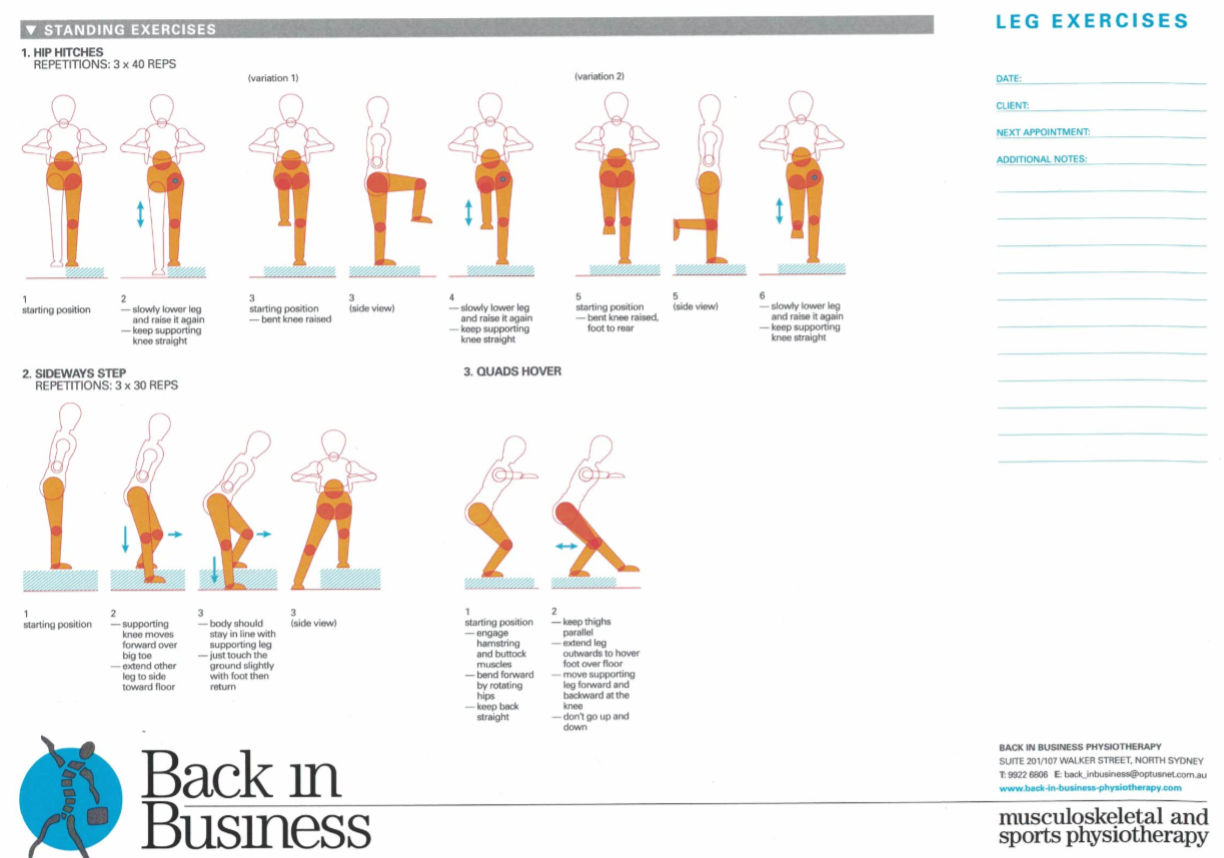
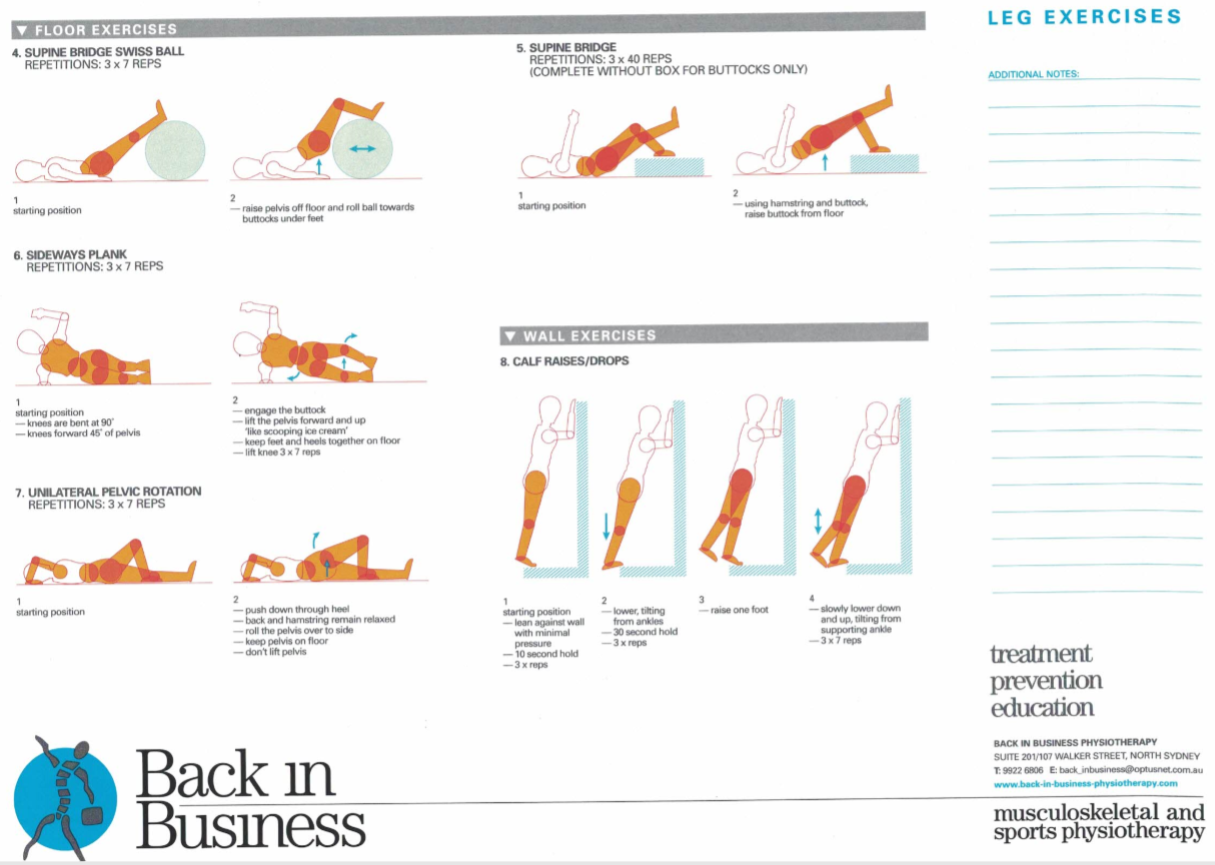
Repetitions : 3 sets to fatigue
Calf muscles are particularly important for propulsion but also for shock absorption, as they can absorb up to 70% of the forces going into the knee when running down hill. Skipping and hopping can be very useful exercises to improve calf function.
Other examples of sports which can be used to activate neuromuscular 'slings' include indoor/outdoor rock climbing and the bouldering gym.
The 'Butt' comes before the core.
Gluteal contractions activate abdominal core muscles as well as enhance the upper limb strength.
Core and back exercises
The final Fitball exercise is a good example of the differentiation of the internal stabilising muscles versus the external 'sling' muscles. Exercise 22a involves pure hip rotation - meaning that only the leg moves due to the 6 deep lateral and medial rotators of the hip controlling leg movement. These muscles only cross one joint and act purely on the joint in an endurance stabilising capacity. Exercise 22b is NOT a progression of 22a. This exercise invokes the external 'sling' muscles, in a co-ordinated synergistic manner combining muscles that cross the knee, hip, pelvis, low back and lower 6 ribs. Hence, the deep muscles control the axis of rotation around the joint and provide powerful feedback (proprioception) to the brain, whilst the superficial muscles are responsible for 'energy transfer'. One should not be trained to the detriment or neglect of the other.
Take home message : Races are won and lost by the ability to run quickly downhills and traverse steep terrain. Learning to master these biomechanical attributes, through targeted exercise, not only optimises performance, it reduces the risk and probability of injury. However, 'transference of learning' through internal visualisation of these specific exercises, to terrain running needs to occur. Similarly, whilst in terrain, think about the exercises, or even execute one or more of them, in terrain e.g. hip hitches or some reverse lunges, and then continue to run. Feel the difference and the 'new spring' in your stride.
Progressive Resistance Weight Training

- Strength : 3 -> 4 sets of 5 repetitions with several minutes rest between sets. Promoting mechanical fatigue
- Conditioning -> endurance 3 x 20-30 repetitions with only 60 seconds rest between sets. Promoting metabolic fatigue
- Power : Proactive potentiation resistance squats followed by box jumps. 2 -> 3 days between workouts. Promoting ballistic mechanical rebounding (potential energy into kinetic energy). a bit like a stretched rubber band recoiling back to the shortened position
Generally, muscles who perform an eccentric contraction (jumping down) prior to a concentric contraction (jumping up), enhance the concentric contraction. However, if not conditioned appropriately, athletes will suffer DOMS within 8 hours, which will gradually worsen up to 48 hours post exercise.
Doing alternative sports during the transition phase can aid in attaining strength, endurance and power. Such sports need to be ballistic fast reactive multi-directional. Examples are soccer, squash and serious table tennis.
Plyometrics : "nose behind toes"
Plyometrics uses the physical concept of turning kinetic energy (KE = 1/2mv2) into potential energy (PE =mgh) and vice versa
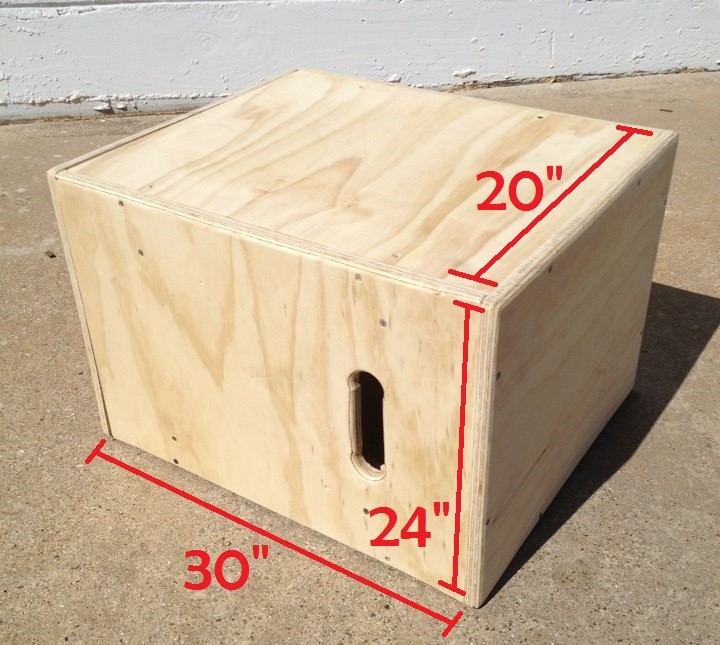
Various heights depending upon size of person and ability to jump : 40 vs 50cm
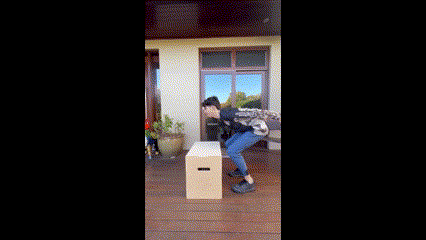
Hands from behind to the front
Important to land in 1/4 squat.
Hip wide feet - with emphasis on the knees staying above foot/ankle whilst the pelvis stays back on landing

Sideways step ups can be progressed to sideways jump ups as well as 'cross overs' to the other side - good for steep terrain traversing running
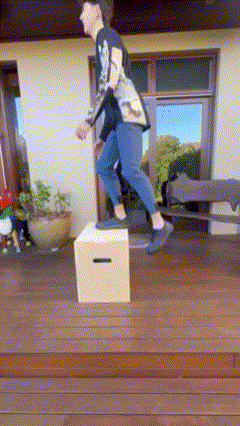
Reverse lunge step down - pelvis drops and knee stays above ankle and mid foot - emphasis is on the posterior sling : hamstrings and gluteal muscles. No tension in the knee.
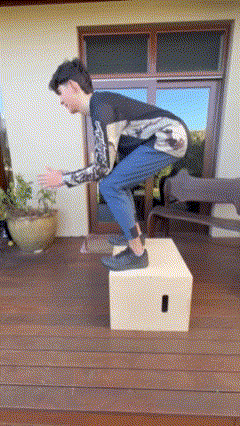
loading upper 2/3 of thighs and glutes. Taking the knees back, takes tension out of the knee joint.
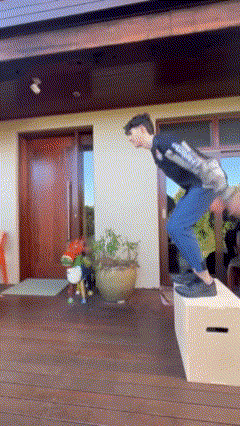
Note the pelvis dropping vertically

Again the emphasis is on the pelvis dropping vertically. Note : the knee moves forwards and backwards horizontal to ground (NOT up and down). Sensation of strain should be in the upper hamstrings, glutes and upper 2/3 of quads (NOT in the knee)
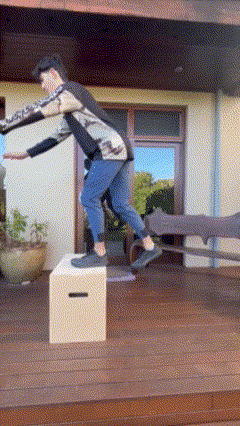
Pelvis drops down and back whilst the knee maintains alignment in the hip and ankle.
- Go down slowly, stop part of the way and return.
- Vary the amplitude and speed.
- The slower you go, the greater the amplitude of oscillation.
- Conversely, the faster you go, the smaller the oscillation amplitude.
- Hereby, the greater the number of motor units recruited, will enhance the cortical representation and variability of muscle recruitment
- .Additionally, vary the point where you stop and change direction
- Thereby optimising the ranges of motion where motor unit firing can occur..
Progression
- preloading resistance training
- weighted vest or ankle weights
- using a dumbbell in each hand or a kettle bell
- set up a series of boxes
Sports such cycling, cross country skiing, telemarking, and speed skating can have similar effects on activating the muscular slings across the body, when done correctly.
Importantly, for transfer of learning from exercise to sport specific task, visualisation and internal mental imagery of the task should be performed. For example, whilst doing the plyometrics box, visualise a forest and the map whilst doing the task. Later in training, whilst running up or downhill, visualise, from within, the plyometrics box. Further reading on mental training and orienteering can be found here : https://www.back-in-business-physiotherapy.com/sports-performance/orienteering.html
Summary
- muscles have a dual function as a mechanical organ of loading and movement as well as an important immune function
- muscle mass allows for the adaptation to training and sport loads as well as providing a reservoir of protein for immune function
- muscles have a synergistic function with the gut
- recuperation is the ultimate goal of any sporting endeavour
- alternate sports can be used to improve ballistic performance capacity as well as to engage the muscular slings across the body
- muscular slings are inherently 'innate', they just need to be 'woken up' and activated They protect the joints from excessive or inappropriate loading.
- the Glutes activate the core, which gives both upper and lower limb strength by providing a stabilising point of inflection in a system which oscillates
- elongation through the upper neck (Alexander Technique), broadens the shoulders, lifts the pelvic floor, thereby stabilising the core, opens the diaphragm to lateral breathing, which allows hip flexors to work independently, as well as encourages the pendular movements of the arms which create the rhythm of the legs
- females have some different hormonal and biomechanical characteristics when considering 'periodisation' and specific exercise regimes (further reading : females and soccer injuries)
Conclusion
Injuries can be avoided by adaptively loading the body through sports specific strategies which include
- Don't train when you are ill
- Periodisation of training
- Nutrition - magnesium as well as both energy, immune and anti-oxidant considerations
- Specific exercise tasks for activating the neuromuscular slings for dynamic stability in uneven terrain
- Progressive resistance gym training for running uphill
- Plyometric exercises for running up and downhill, as well as for one legged and two legged jumping, landing and take-off
- Train to run and compete uphill for resistance to metabolic fatigue
- Train to run and compete downhill for optimal biomechanical performance and avoidance of injury
- Contrast baths (ice bath and sauna) for optimisation of recovery (heat shock and cold shock proteins, as well as micro-circulation)
Races can only be won by running fast and especially fast terrain traversing and downhill running. Injuries are more likely to occur as the intensity or volume of loading increase. The same exercises which improve mechanical efficiency and performance are therefore the same exercises that reduce the likelihood of injury. Orienteering races are won, in a fashion, which resembles the 'periodisation' of training - running fast downhill, fighting metabolic fatigue going uphill, recovery on the flats, transition into the next phase of the competition.
Further reading on mental and mechanical stress and the immune system can be found here : https://back-in-business-physiotherapy.com/physiotherapy-teaching/rome-presentation.html
Uploaded by Martin Krause on 16 June 2024
Updated : 21 October 2024




